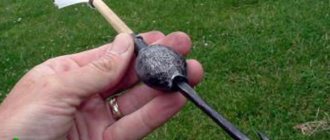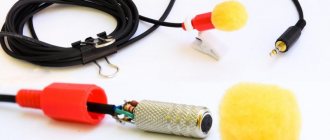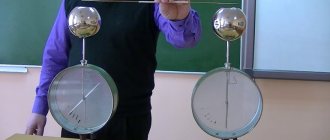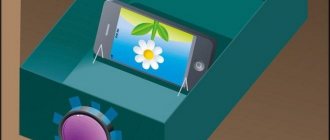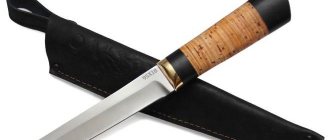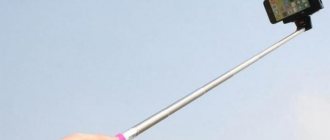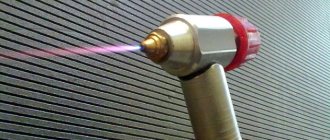Option 1. Paper boat
The proposed version of a paper flotation device will be interesting not only for adults, but also for children. It is best if you do the craft together with your child in 2 copies (one you yourself, demonstrating each action step by step, the other child, repeating your actions).
To begin, prepare 2 landscape sheets. Newsprint paper will not work, as it will quickly get wet from exposure to water (you can practice on it, but it is better to make the craft itself from thicker paper). Cardboard is also not suitable for making this boat, since you will need to bend small fragments many times, which is not so easy to do when using cardboard in your work.
Having placed a sheet of paper in front of us (landscape orientation), we begin to work:
- We bend it in half.
- We fold the resulting part in the middle and unfold it back. This is necessary to obtain the midline.
- We fold the corners to the fold line and connect them together.
- A thin rectangle is formed under the bent corners. It should be folded over the corners.
- We turn the workpiece over and do the same with the rectangle on the opposite side.
- Next, we open the workpiece from the inside, connecting opposite corners. This results in a square piece.
- We bend one of the corners up on one side. We do the same with the other angle.
- After this, again, as if opening the resulting triangle from below, we get a smaller rhombus. You should carefully pull the upper corners in different directions to turn the boat around.
Now you can invite your child to decorate with felt-tip pens or decorate the deck of the ship by gluing stickers. Having made several of these crafts, feel free to organize a competition for the fastest boat sailing along a stream or small river.
Option 2. Cardboard boat
The proposed version of a paper boat is most likely not suitable for playing in water, but it will undoubtedly decorate a child’s room. It will be difficult for a child of primary school age to make such a model on his own, so offer him your help.
Required materials and tools:
- thick cardboard;
- wooden stick and 2 skewers (toothpicks);
- a small piece of twine;
- sail fabric;
- a simple pencil, a ruler (preferably iron), a black marker (felt-tip pen);
- glue gun;
- stationery knife;
- a piece of foam plastic (if not, you can use an eraser or plasticine).
Important! Before work, give instructions on how to use a utility knife, warn your child that this is a cutting object, and if handled carelessly and inattentively, it can cause cuts and long-healing injuries.
Step-by-step instructions:
- First of all, print the ship templates on a printer (the size of the craft will depend on the selected scale of the printed parts).
- Transfer the templates to cardboard (you can paste a printed sheet or outline the cut out templates).
- Using a utility knife, cut out the pieces from cardboard. To ensure that the lines are straight and for ease of cutting, use an iron ruler in your work.
- First glue the sides of the ship together with a glue gun.
- Glue the bottom to the side parts.
- Now let's start making the hold. To do this, take a rectangular piece of cardboard, the width of which coincides with the width of the ship, and the length is equal to the distance from the back wall to the place where the windows end, plus the height from the row of windows to the bottom. We bend this part (measure the height from the bottom to the windows).
- We insert the prepared wooden stick into a piece of foam plasticine.
- We glue the cardboard rectangle to the back wall of the boat (we glue all the joints).
- Near the resulting captain's bridge we attach the mast.
- We fix 2 toothpicks to the vertical mast using an adhesive gun in a horizontal position. For beauty, we tie the joints with twine.
- We make a sail from fabric and tie it to the mast.
- To make the model look more natural, we draw circles-portholes on the side, and make an imitation of a gangway from a small rectangle of cardboard.
The ship is ready! Now your young sailor can safely set off on a trip around the world!
Complicating the design
The simplest homemade periscope will not allow you to see an object located in the distance in detail. It would be tempting to combine the capabilities of a periscope and a telescope. An option for making a periscope with the function of zooming in on distant objects is shown in the diagram.
The basis is the same simple periscope, but two new elements are added to it: a lens and an eyepiece, taken from a ready-made telescope. Having understood a little about the basics of optics and familiarized yourself with the options for making homemade refracting telescopes, you can choose the lenses for the lens yourself.
When assembling a periscope with your own hands based on the parts of a finished telescope, you must ensure strict adherence to one rule (circled in red). The final distance between the lens and the eyepiece should be exactly the same as it was for the telescope taken as a basis.
It is worth taking care of the possibility of adjusting (leveling) the focal length to adjust the sharpness of the device. In the diagram, the eyepiece is inserted into a special eyepiece tube.
Source
Hello again. This time I propose to go back a little to childhood, namely to the fourth grade of a Soviet-era high school, to a natural history lesson and to make an interesting and useful optical device called a periscope. I was forced to make it by the need to find a wire embedded in the suspended ceiling. Moreover, it was necessary to see this wire in order to hook and pull it through the fastening profiles. In general, this homemade product allows you to look where you need eyes like a crab - retractable on stalks, and not only behind the suspended ceiling, but also into the ventilation duct or box with plumbing pipes. I foresee proposals to use a miniature video camera with a monitor, but, firstly, it is cumbersome and inconvenient, secondly, it is expensive (the device will not often be in demand), and thirdly, the purchase of such a camera is fraught with problems with the law (Article 138.1 of the Criminal Code of the Russian Federation).
To make a periscope, you will need the following materials: 1. Plumbing PVC corners 90° ø40 and ø32 mm. 2. A piece of plumbing pipe ø40 3. A mirror made from a powder compact (the thinner the better) 4. Thin glass (organic can be used) 5. The neck of a plastic bottle 6. The insides of a Chinese LED lantern 7. “Cold welding” 8. PVC glue (I recommend COSMOFEN PLUS-S) 9. Glue “Moment 88” 10. Paint (optional, does not affect the work)
Tools: 1. Miter box 2. Hacksaw 3. Diamond needle files 4. Sandpaper of different grits 5. Soldering iron with accessories
For plumbing corners, using a miter box and a hacksaw, cut off the top of the corner at 45°. Naturally, we first outlined the boundaries of the cut with a marker (we move the internal joining point of the pipes to the external, diametrically opposite part of the pipe).
Periscope - installer's assistant (with backlight)
Hello again. This time I propose to go back a little to childhood, namely to the fourth grade of a Soviet-era high school, to a natural history lesson and to make an interesting and useful optical device called a periscope. I was forced to make it by the need to find a wire embedded in the suspended ceiling. Moreover, it was necessary to see this wire in order to hook and pull it through the fastening profiles. In general, this homemade product allows you to look where you need eyes like a crab - retractable on stalks, and not only behind the suspended ceiling, but also into the ventilation duct or box with plumbing pipes. I foresee proposals to use a miniature video camera with a monitor, but, firstly, it is cumbersome and inconvenient, secondly, it is expensive (the device will not often be in demand), and thirdly, the purchase of such a camera is fraught with problems with the law (Article 138.1 of the Criminal Code of the Russian Federation). To make a periscope, you will need the following materials: 1. Plumbing PVC corners 90° ø40 and ø32 mm. 2. A piece of plumbing pipe ø40 3. A mirror made from a powder compact (the thinner the better) 4. Thin glass (organic can be used) 5. The neck of a plastic bottle 6. The insides of a Chinese LED lantern 7. “Cold welding” 8. PVC glue (I recommend COSMOFEN PLUS-S) 9. Glue “Moment 88” 10. Paint (optional, does not affect the work)
How to make a periscope with your own hands
- cardboard,
- 2 mirrors,
- glue, scissors.
To begin with, we took 2 sheets of A4 cardboard. The larger the cardboard format you have, the longer the periscope can be made, and accordingly it will be much more interesting for the child. The sheets were glued together along the long side with tape. Next, we measured the length of the mirror with a ruler. We had 2 square mirrors with a side length of 6 cm. We drew a scan on cardboard
Please note that the width of the main strips should be equal to the side of the mirror (in our case it is 6 cm). Don't forget to leave allowances for gluing. Now we carefully tried to glue everything together with glue.
But since we didn’t have much patience to wait for everything to stick together well, we also sealed all the seams with tape: scratch: The result was such a wonderful device. All production was accompanied by stories and fantasies about the submarine. Vladik even had to restrain his desire to test the periscope in the water. :wacko:
Vladik is very impatient. He practically pulled the finished periscope out of my hands. He didn’t even let mom play enough.
Then we began to look around everything:
We looked at the second floor of the bunk bed.
They put the toy on the closet. If you just look, then only the cap is visible, but through the periscope you can see that it is a teddy bear in a cap.
Then they looked out from behind the needles at each other.
We looked out the window. It is interesting that when looking from the second floor you cannot see the base of the tree, but through the periscope you can easily see the tree near the ground.
We had great fun. In the evening I brought the youngest Makarchik from the nursery. And then the chase began, with the periscope being taken away. New and unknown things are always in great demand in our family.
Of course, Vladik took our craft to kindergarten. I wonder if the toy will return home intact or with spare parts.
Happy crafts and experiments.
everything relevant for fathers and the whole family
How to make a periscope with your own hands?
The simplest option for making a periscope is to attach two mirrors with plasticine (you can get them from unnecessary ladies' cosmetic bags, broken children's toys, etc.) on a long cane according to the above diagram. Thus, you will get a simple but fully functional periscope.
However, there are more sophisticated systems. To make it, you will need one, two or three Pringles cans (depending on the length of the structure. However, you should not take more than three, since at this distance the field of view will be so small that you will hardly be able to distinguish anything). If necessary, carefully remove the bottom of the future middle can in the design. Now make rectangular holes on diametrically opposite sides of the jar at an angle of 45 degrees to the horizontal as shown in the figure. Pass a strip of tin through the holes obtained, a couple of centimeters long longer than the diameter of the cylindrical box and about 1 cm wide. Make an observation hole in the appropriate place on the bottom of the jar. (see picture)
Now attach a flat mirror with plasticine or glue (can be round, or can be rectangular). Perform a similar operation with the other end of the periscope, only in mirror symmetry, to obtain a design that matches the description given above. Now connect all the components into one whole, wrap the joints with opaque paper and secure with adhesive tape. Adjust the position of the mirrors in the best way (adjust) and bend the protruding ends of the sheet metal to secure the position of the mirrors.
Source
Periscope rules that should not be broken
Before you dive headlong into exploring the capabilities of the Periscope application, be sure to read the Community Rules.
The rules prohibit:
- using Periscope for illegal purposes or to promote illegal activities (pornography, violence and cruelty),
- disclosure of confidential information (passport information, credit card numbers, exact residential address, telephone numbers and email address),
- to misinformation (do not impersonate other people in order to mislead),
- for selling or buying accounts,
- against spam during broadcasts (both for speakers and viewers).
- Violating the Periscope Community Guidelines may result in your account being blocked.
I also recommend paying attention to copyright protection measures...
Making a periscope from cardboard - assembly instructions
Have you always wanted to see through walls? No problem - we'll show you how you can at least look around the corner. And with a periscope. In this DIY tutorial we'll show you how to make a periscope - simply from a cardboard tube or an empty milk carton.
A periscope is a periscope that allows you to view an object from the lid. You can literally see around the corner. Johannes Hevelius invented a useful instrument in 1647 called a polemoscope. Since then, the periscope has been used mainly for military purposes, such as on a submarine or in a bunker. Die-the-corner-Gucker is a popular children's toy that you can easily make yourself. When the mirrors are positioned correctly, objects are redirected into the periscope so that you can see around obstacles without revealing yourself.
Milk cardboard periscope
A quick and creative way to make a periscope is to use a square milk carton. The cardboard box cuts well but remains stable and the perfect size.
Once the milk carton is empty, place it in the sink and let it dry a little. Then, as in the description above, cut two windows diagonally into the sides of the box. Then you can rinse the box with water again, now the small mirrors are prepared and then glued into the box.
Application
Humanity has been at war throughout the history of its existence. Moreover, the leap in the development of deadly devices that kill at a distance occurred almost instantly from the point of view of world history. Bows and crossbows replaced spears and slings. The arrows began to reach the enemy at previously unprecedented distances, the power of the shot and the accuracy of the shooters were constantly growing.
It is not surprising that the artisans soon wondered how to make a periscope that would allow them to observe the movements of the enemy while remaining invulnerable. In the 17th century, the periscope began to be used during the siege of fortresses to monitor the besiegers without the risk of being hit by an arrow or crossbow bolt.
And in the middle of the 19th century, when many countries began to make massive attempts to build underwater vessels, the periscope almost immediately became an integral part of them. Its device was perfectly suited for spying on conventional surface vessels. Moreover, observation could be carried out secretly, without surfacing, and this is the most important requirement when conducting military operations.
Invention
The word “periscope” itself, loosely translated from ancient Hellenic, sounds something like “I look around.” The prototype of this device has been known since the 15th century, and it was invented, as often happens, not at all for what it is used for now - monitoring the enemy during military operations.
The simplest periscope was made by Christian pilgrims with their own hands, attaching two fragments of a mirror to a stick at an angle of 45°.
This simple device was used to be able to see over the heads of the crowd at the Aachen festival. For the time being, the invention played a modest role as a fun toy, but already in the 17th century the situation changed.
Periscope PIR-15 USSR High aperture
Periscope PIR-15 USSR Z-d Geodesy High-aperture with drying module Manufacturer: USSR, Geodesy Plant Type: with mesh Year of manufacture: 1960s Condition: excellent! Availability: no VIEW SIMILAR DEVICES Equipment of the device: Case: yes (soft case “original” canvas with compartments for accessories) Shoulder strap: yes (tarpaulin) Eyepiece cover yes (real leather) Lens cover: yes (natural leather) Light filters: yes 2 pcs . (1 yellow anti-fog, 1 dark green anti-glare) Drying module: there are 2 pcs. (1 main in the device + 1 backup in the case) Key for changing the drying module: yes Mounting bracket: yes (with azimuthal notch) “Measuring scale in the field of view” grid: yes (goniometer) Anti-reflective coating: yes Instructions for use: yes Dimensions HxWxD, mm: 640x129x85 Weight without case, kg: 2.5 Brief description: High-magnification periscope PIR-15 is designed for general observation and detailed study of terrain and individual objects, for measuring angles in horizontal and vertical planes and estimating the distance to objects. To give the periscope a stable position (for long-term observation) serves as an installation bracket, which with its threaded part is screwed into any object, and with a pin is connected to the periscope handle. The threaded rod and the bracket pin are connected to each other by a hinge, which allows you to tilt the periscope in a vertical plane within ±40 degrees . To ensure orientation during all-round viewing, there is an azimuthal scale along the circumference of the cylindrical part of the pin. The device is suitable for hunters, wildlife lovers, and ornithologists. The magnification of the device is 15 times, the lens diameter is 60 mm. The device is equipped with a large lens size to improve clarity and contrast (aperture). The total length of the periscope is 64 cm, the extension length is 45 cm. Smooth diopter adjustment of the eyepiece ranges from -5 to +5 diopters, which will allow almost anyone to get a clear and high-quality picture without the use of glasses. The periscope is equipped with a lens visor to protect against side light and adverse weather conditions. An antireflective coating is applied to the optical elements. Also in the field of view of the device there is a goniometric grid for estimating the distance to objects with known dimensions. The periscope is made of metal, weight 2.5 kg. Comes with an original canvas case with a shoulder strap and a protective seal for the objective assembly.
Magnification, multiple (times): 15 Lens diameter, mm: 60 Field of view angle, degrees: 7.30 Exit pupil diameter, mm: 4 Exit pupil relief, mm: 9.5 Resolution, arcsec: 4.2 Extension length, mm: 450 Diopter setting of eyepiece, diopter : -5..+5Prism type: combined systemBody material: metalFocusing: eyepieceThe device is in new condition.Attention! All images of the device are real and belong to .Dear customers! When you order, you receive exactly the device that you see in the images!
QUICK JUMP BY CATEGORIES:
ALL USSR BINOCULARS BINOCULARS WITH A GRID BINOCULARS WITHOUT A GRID BINOCULARS REDOPTIC ANTIQUE THEATER BINOCULARS USSR MONOCULAR PERISCOPE USSR
HOME | ALL USSR BINOCULARS | THEATER BINOCULARS USSR | MONOCULAR PERISCOPE PIPES USSR | ALL CARL ZEISS JENA BINOCULARS | THEATER BINOCULARS GERMANY | REDOPTIC ANTIQUE | ACCESSORIES FOR BINOCULS (SPARTS) | MAGNIFIERS | VALDAI BELL | FEEDBACK SERVICE | CUSTOMER REVIEWS | INFO | Home Site Map
Make a periscope
What you need for periscope:
- Cardboard tube
- cutter
- pencil
- scissors
- cardboard
- Mirror foil (or small mirrors)
- Hot glue gun
- Acrylic paints and brushes
- Washi tape, colored tape
instructions:
Step 1: First, the viewing windows are cut into the cardboard tube. Using a cutter, cut a 4cm x 3cm window into the top of the cardboard tube, about 3 – 5cm from the edge. A second window is cut out at the other end, exactly at the back of the cardboard. It's just as big.
Step 2: Next, cut two cardboard rectangles, each measuring 4cm x 3.5cm. These two cardboard pieces are then glued to one side with mirror foil.
3rd step: The mirrors are now fixed inside the tube. With a little hot glue you can stabilize them at the back. Insert the mirror into the window so that it tilts towards the other end of the pipe. The second mirror is glued into another window with exactly the same orientation. Overhanging corners can be easily cut with scissors.
Step 4: Place the cardboard tube on a piece of cardboard and trace the outline with a pencil. Then two cardboard circles are cut out in this format. Cover the test tube with cardboard circles from the bottom and top to prevent light from entering inside. Using hot glue, the cardboard is attached to the edges.
5th step: finally the periscope is decorated. To do this, you can stick on multi-colored foil, paint cardboard with acrylic paints, or cover the pipe with crepe paper. There is no limit to your imagination.
Step 6: To prevent the light beam from entering the periscope, we now glue the edges together using Washi tape.
Periscope is now used as follows:
Move the periscope to the corner you want to see. Turn the open window forward. The mirror image of the motif located around the corner is now thrown into the tube on another mirror. Through the window pointing towards you, you can see the picture clearly.
How to assemble a periscope from scrap materials?
- Author Nikolay
- 8 April 2022, 16:26
It is unlikely that “branded” toys bought in a children’s store can teach a child anything: it is strange to expect an educational function from a car or robot. It’s not at all difficult to make an exciting toy for your child that can not only keep him busy, but also teach him the basics of optics. To do this, you just need to find two identical mirrors, a sheet of foam plastic and some free time. Read below to learn how to assemble a real periscope from scrap items with your own hands.
So, you will need:
- Two square or rectangular mirrors, preferably the same area.
- Material for making the periscope body. In principle, you can use cardboard for this, but we recommend cutting out its parts from a sheet of foam plastic - this will make the periscope more durable and solid. This type of foam is often used for packaging household appliances and is easy to obtain. As a last resort, you can buy it via the Internet - now a sheet of foam plastic with an area of 1x1 m costs less than 100 rubles.
- Universal glue
- A knife for cutting cardboard (which, of course, can also cut foam)
The design of the periscope is very simple: it is an elongated box with two opposing holes at its different ends. The holes should have mirrors fixed at an angle of 45 degrees. In general, the device diagram looks like this:
The length of a homemade periscope can be about 40 centimeters, and the width and depth of the case depends on the size of the mirrors: their edges should fit closely to the inner walls of the case.
- Cut two identical panels from foam plastic, 40 centimeters long, and the width of which will be equal to the “depth” of the mirror + double the thickness of the foam sheet.
- Then cut two identical 33cm panels that are the same width as the mirror.
- After this, cut out two “lids” that should cover the box at the ends - their area will be equal to the area of the mirrors.
- Glue the mirrors to the 40cm panels at a 45 degree angle as shown in the picture. For strength, you can “recess” the edges of the mirrors a little in the foam by cutting holes for this.
- Glue two 33-centimeter panels to the existing “frame” of two side walls and mirrors. They should fit snugly between the side panels. Glue them so that each of them forms “inspection holes” on its own side.
- All that remains is to glue the “covers” on both ends of the periscope.
That's all! Good luck!
Metal periscope
Today we will try to make a real, metal periscope. able to withstand various types of environmental influences.
As a child, playing war games, I always wanted to have a periscope, so that I could observe the positions of my friends from an ambush without giving up my position. But unfortunately, at a young age, without sufficient experience and skills, all that was left was to dream about it. Today, although I am no longer at the right age for such toys, I still decided to make my childhood dream come true, and perhaps you readers will decide to make the same toy for yourself or for your children.
What do we need for this?
Cuttings from aluminum frames, which I asked from the guys from the workshop for installing plastic and aluminum windows. They immediately cut them for me at an angle of 45°, we also need a piece of mirror and black cotton material.
First we need to get rid of unnecessary details.
After we have removed all unnecessary material, we cut the material into strips and glue them with rubber glue to the profile from the inside. This is necessary in order to get rid of glare.
We align the mirror perpendicular to the inner plane and apply hot glue. After waiting a little, we tilt the mirror, guided by the approximate line that needs to be drawn in advance.
After the glue has completely hardened, all that remains is to glue all the parts together with quick-drying epoxy glue. Before gluing, be sure to put all the parts together, look through the periscope and make sure that the mirrors are installed correctly.
As it turned out, the length of the small pipes was too long. It is inconvenient to use such a periscope. I had to cut it off a little.
Well, that's all, the periscope is ready, it's time to spy.
BEING THE AUTHOR OF THIS ARTICLE, I PROHIBIT COPYING TEXT, PHOTO AND VIDEO MATERIAL FROM THIS SITE TO OTHERS.
"Periscope": broadcasting to a computer
How to watch Periscope online broadcasts on a PC needs to be discussed separately. If you don’t have access to a smartphone with the installed application at all, but you want to search for curious streamers yourself online, you’ll have to install an emulator of the Android operating system. You can download the most stable build from Bluestax on the developers’ website. The program will allow you to find streaming and recent videos, subscribe to the necessary channels, and receive a link to events broadcast online. To do this, you need to install the Periscope application inside Bluestax using the Play Market. However, this option is not suitable for those who want to observe the lives of other people without registering. The answer to the question of how to watch a live broadcast on Periscope from a computer will be incomplete. The fact is that it is not yet possible to enable streaming video inside the emulator. Video (broadcast) Periscope online is too resource-intensive for this utility. However, having received the link you are looking for, you can send it to Twitter or open it directly in the browser, immediately going to the online broadcast.
Thus, in order to watch the Periscope online broadcast through a computer now, all you need to do is essentially just get the necessary link, which can be opened in just one click. You can get these links like this:
- Through the emulator described above.
- Via a smartphone, if the program is installed on it, but the user wants to watch Online Periscope on a large computer screen or even a TV.
- Through Twitter accounts of other users.
In addition, on the social networking site it is possible to get to a random channel. Read about how to watch Periscope online broadcasts from a browser without downloading to your computer in a separate article.
How to make a periscope with your own hands
A periscope allows you to look at something from around a corner or from a higher point of view than usual. So let's look at how to make a periscope. While modern submarines and other high-tech vehicles typically use a more complex system of prisms and lenses, the basic mirror periscope described below can easily be made at home and gives a fairly clear idea that it was widely used for military purposes in the twentieth century.
Making a Cardboard Periscope
Find two small mirrors that are approximately the same size. You can use any flat mirrors, whether the frame is rectangular, round or some other shape. The two mirrors don't have to be the same shape, but they should be small enough to fit inside the milk carton.
We continue to figure out how to make a periscope.
Cut off the tops with two clean milk cards. Find two empty milk cartons, each at least one quart (one liter) in size and wide enough to fit your mirrors. Cut off and discard the triangular top of each, then rinse the inside thoroughly to remove odors.
- A long, sturdy cardboard tube may also work.
- You can use a large, flat sheet of sturdy cardboard instead. Lightly trim it using a craft knife to divide it into four sections, then roll it into a box and tape the tape together.
Drain the two boxes together. Use packing tape or other strong tape to tape the open ends of cardboard boxes together, creating one long box. To hold boxes together more securely, try taping the inside
part of the box together on one side and then tape all four outer surfaces.
You can glue two tubes or two homemade cardboard boxes together in the same way to make a longer periscope. However, the longer the periscope, the smaller the image will be.
Cut a hole on one side large enough for the mirror. Place one of the mirrors on one of the vertical sides of the milk carton, about 1/4 inch (6 mm) from the end. Trace the mirror with a pencil, then draw pencil marks to create the hole.
- A craft knife may be the simplest tool for cutting a hole, but it should only be used with adult supervision as it is very sharp.
- If you are using a cardboard tube instead of a milk carton, smooth it slightly to trace the mirror.
Simple DIY periscope
We all know that the periscope is one of the main attributes of submarines, as it allows you to observe the sea horizon without surfacing. It is used in ground forces, for example, when you need to observe the surface from some trench. In order not to take risks and not stick your head out, this device is very useful. This video tutorial suggests making a simple homemade periscope with your own hands. It can decorate military-themed games like Zarnitsa, which was very popular among pioneers in Soviet times. The craft is suitable for children's creativity and for learning the laws of physics.
What you will need for the craft.
You need 2 cardboard boxes; boxes from 40-watt energy-saving light bulbs work very well. The shape and dimensions are ideal for our periscope. If there are no suitable boxes, you can make them from cardboard. You will need a utility knife, 2 pocket mirrors and a glue gun.
Periscope on a computer - how to install?
It’s very easy to install and use Periscope for Windows; all you need to do is download and install the BlueStacks application in one click
(Installer updated)
After the file is downloaded, double-click on the shortcut to begin installing the application.
Click next for the standard Windows procedure.
The first stage is finished! Congratulations, you have a full-fledged Android emulator on your computer. Now let's download our Periscope program to it
1. Go to BlueStacks, it’s like a tablet or smartphone on Android, everything is the same.
Go to the Android tab. Click on "Search".
2. Write “periscope” in the search bar and press “Enter”
3. The following screen should appear:
4. Click Continue. At this stage you need to register, or enter your Google account. This is done only once.
If you have an account, click “Existing”, enter your username and password and go directly to.
If you don't have a Google account, I'll show you how to create one in a minute.
Click New.
5. Enter any name (it will be shown in all google services)
6. Enter your google email login
7. Enter your password. Enter numbers and letters, try to use at least one lowercase and one uppercase letter.
8. On the next screen, click “Not Now” and move on to the next step:
9. Next, leave everything as it is and click Forward - arrow on the right
10. Congratulations, you have practically created an account, click “I Accept”
11. Enter the characters from the picture (check for a robot)
12. Wait until your account is activated (may take a few seconds, up to a minute)
13. On the next screen, click Continue
14. Next you need to log in to your account. We created it, so it will appear in the list. Select it
15. You will see a message at the bottom “Registration completed successfully.” Click Continue
16. Now that's it! "Go!"
You have registered with Google! Now your emulator is a full-fledged smartphone / tablet.
Option 4. Viking boat
For school-age children, invite them to glue together a Viking ship. Undoubtedly, such work will appeal not only to boys, but also to young ladies who will be able to apply their creative endeavors to decorating the ship.
- scissors (with blunt ends);
- cardboard box (you will need a double cardboard box);
- wrapping paper (for decoration);
- PVA glue;
- several toothpicks or a piece of wire.
- Glue together the parts of the ship frame.
- Decorate the joints with colored paper with patterns.
- Attach the glued front part to the front of the frame.
- Glue strips of cardboard (benches) inside the boat.
- Make a sail from wrapping paper and thread it onto a skewer (a small piece of wire).
- Stick the sail (through the middle bench).
- Make oars from toothpicks.
Decorate the finished ship with Viking patterns and symbols, and also place sailor figures inside. The children will play with such homemade toys with interest, organize sea battles, and compete.
Homemade simple periscope
Making a simple periscope with your own hands is not at all difficult. In order to acquire a means of covert surveillance, you need to stock up on two small mirrors. You can buy round cosmetic mirrors, or you can cut out two rectangular mirrors with a glass cutter (who has such skills).
The next thing you need is a body. Here fantasy is not limited by any boundaries. Any oblong object made of a fairly hard but workable material. Even a narrow and long sweets box will do.
A drawing of the periscope is shown in the figure. The transformation of a Montpensier box into a means of espionage occurs as follows:
— Inspection holes are cut at the bottom and top of the body - on opposite sides, as shown in the diagram.
— Mirrors are mounted inside the housing at an angle of 45° to the vertical axis. The mounting of the mirrors should provide the possibility of their adjustment; this will need to be done later and ensure that the observation objects are visible through the periscope, and not the insides of the device.
One of the options for making a periscope with adjustable mirrors is shown in the additional diagram. The mirror is glued to a base made of multilayer plywood; there are adjusting bolts at 3 points along its edges. To ensure that the mirror always occupies a stable position, a compressed spring is inserted between the mounting plate and the base.
Mom Folder
But before we begin building such an “all-seeing” periscope, let’s recall the structure of a conventional periscope using the example of its elementary model (Fig. 1).
By the way, we note that a real periscope used in military equipment is, of course, very complicated. It contains mirror prisms, an eyepiece and a lens system. Moreover, all this is in double quantity - for each eye. Nevertheless, even the simplest periscope in design will allow you to make interesting observations.
To build it, you will need two similar rectangular mirrors, for example, pocket mirrors from a haberdashery store, measuring approximately 30x40 mm.
The periscope body is made of cardboard. The internal cross-section of the pipe and elbows is 30×30 mm. Pipe length - 250-500 mm (excessive length will not only make the structure heavier, but also narrow the field of view), elbows - 70...80 mm.
Having glued the pipe pattern, strengthen its joint with a glued strip of thick paper (for example, whatman paper). From the side of the piles, two windows measuring 30x30 mm are cut out in the pipe, in which the mirrors are fixed with PVA glue, fixing them with four (two at the top and bottom) matches, cleared of sulfur. Install the mirrors at an angle of 45 degrees (the light from the top window should be visible in the viewing window),
A window measuring 30x30 mm is also made at the knees. However, part of the cut material is a strip the width
1 cm - not removed, but used to secure the elbow to the pipe.
To eliminate stray reflections (light exposure), the inner surface of the pipe and elbows is blackened, for example, with ink, and then coated with colorless nitro varnish of the NTs brand. It is advisable to cover the outside of the periscope with any varnish, preferably bright nitro varnish. This will give it elegance, as well as strength and resistance to moisture.
Now let’s look at the device of the “all-round” periscope, the diagram of which is shown in Figure 2. At the bottom, as in the all-round periscope, a mirror is installed. But in the upper part there is no longer a zarkapo, but a mirror pyramid, reminiscent of an inverted Egyptian one. It is fixed on a square sheet cut out of plywood or hardboard and suspended on four racks made of a steel tube with a diameter of 5...6 mm with cones flattened with a hammer. Thin stands are needed so as not to greatly replace the image visible in the lower mirror. Otherwise, all-round visibility will deteriorate due to the so-called “dead zones” that are closed to observation.
Option 3. From waste material
Juice and milk cartons most often end up in the trash. But you can make excellent crafts from them. In this case, we suggest making a model of a boat.
You will need a juice box, a utility knife, colored markers, a wooden skewer, a colored scrap and plasticine (for attaching the mast to the bottom of the ship). We cut out a rectangle-hatch on top, and round portholes on the sides. Entrust the children to paint the ship - they will do it with great enthusiasm. The sail can be made from either fabric or colored paper, the mast can be made from a cocktail tube.
Even from the photo you can see that making a ship out of a box will not cause much difficulty. You just need to be smart and approach this matter creatively.
Option 5. Large ships
Any dad can amaze his child and make an individual toy. No kid will refuse to feel like a pirate or a brave conqueror of the seas and oceans, having such a ship model.
Making a cardboard boat is not at all difficult. Large cardboard boxes (from household appliances), plywood and the desire to please your child are suitable for this.
Each master will choose the assembly principle for himself. And inspiration can be drawn from the numerous examples of ships shown in the photo.
How to make a periscope with your own hands?
Take a look - which method seems most successful to you?
How to make a periscope from cardboard boxes or milk cartons with your own hands
This list contains all the necessary materials:
- two cardboard boxes or two milk cartons;
- two mirrors (flat);
- tape and double-sided tape;
- pencil;
- stationery knife.
Well, shall we get started?
If you choose milk cartons, be sure to wash and dry them thoroughly. In such boxes, cut off the triangular tops.
Step 2. Then you should connect the boxes together in the area of the empty centers with tape.
And by the way, if you later want to increase the length of the periscope, you can attach another box in the center without sides!
Step 3. Attach a mirror to the right side of the box (don't forget to move away from the edges!) and trace it with a simple pencil.
Using the resulting markings, carefully make a cut with a stationery knife. Then turn the box over and do the same procedure, but on the left side.
Step 4. It’s time to insert the mirrors into the prepared holes at an angle of 45 degrees.
They should be attached from the inside with reliable double-sided tape along the top and bottom edges of the mirror.
It is important to remember that adjusting the two mirrors may take some time, so do not rush to fix them as firmly as possible right away. Step 5
Installed mirrors must be completely visible through the holes.
Step 5. The installed mirrors should be completely visible through the holes.
At an angle of 45 degrees, the first mirror will reflect light onto the second. Well, if you are not sure that you have accurately determined the required angle, then continue to adjust the mirrors, looking at the bottom.
Once the angles are adjusted, you will be able to see everything above from the bottom hole, which means your periscope is ready for incredible adventures!
DIY periscope from a Pringles can
Authorization on the site
DIY periscope from a can of Pringles chips (pringles)
Periscope
- one of the simplest, but far from uninteresting optical instruments. Used to shift the observer's line of sight. It is convenient for “seeing” over the heads of the crowd at races and competitions, at sports games. This device consists of two flat mirrors or, preferably, two rectangular prisms, assembled in some kind of casing or holder.
The reflective surfaces are arranged in such a way that they are parallel to each other and located at an angle of 45 degrees with respect to the vertical. Light falls on the upper plane of the mirror or the reflecting face of the prism at an angle of 45 degrees and is therefore reflected at the same angle, deviating, therefore, by an angle of 90 degrees from the original direction (in the plane of the mirrors). Then, similarly, it is reflected at -90 degrees from the second mirror, thereby taking on the original direction. Thus, the image is direct imaginary and appears at a level significantly different from the original one.

